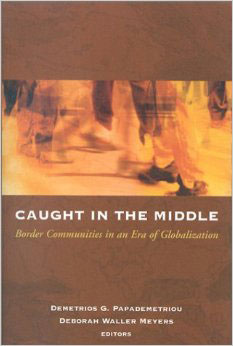Source: Washington
 In a world where the flow of goods and people is tremendous and growing, little attention has been paid to the communities through which these goods and people pass. Caught in the Middle provides a fascinating look into the inner workings and realities of border communities along five international borders: United States-Canada, United States-Mexico, Germany-Poland, Russia-China, and Russia-Kazakhstan. The case studies focus on innovative cross-border initiatives and contribute unique insights into the daily lives and local perspectives of border communities. They also bring a better understanding of border management issues faced by countries worldwide and of the nature of relationships between federal and local governments, community leaders, government officials, and local communities. By shedding light on existing "best practices" and providing comparative analyses of the challenges and opportunities faced by communities, this volume provides valuable lessons for federal, state, and local policy makers, border residents, and researchers alike.
In a world where the flow of goods and people is tremendous and growing, little attention has been paid to the communities through which these goods and people pass. Caught in the Middle provides a fascinating look into the inner workings and realities of border communities along five international borders: United States-Canada, United States-Mexico, Germany-Poland, Russia-China, and Russia-Kazakhstan. The case studies focus on innovative cross-border initiatives and contribute unique insights into the daily lives and local perspectives of border communities. They also bring a better understanding of border management issues faced by countries worldwide and of the nature of relationships between federal and local governments, community leaders, government officials, and local communities. By shedding light on existing "best practices" and providing comparative analyses of the challenges and opportunities faced by communities, this volume provides valuable lessons for federal, state, and local policy makers, border residents, and researchers alike.
Advance Praise
"This astutely conceived work addresses itself to a refreshingly precise subject: What are the appropriate functions of borders between states in the age of globalization? Drawing from case studies that reveal the wide range of situations encountered in the world at large, Papademetriou and Meyers elaborate guidelines for an approach to border management that will effectively promote North American integration."
—Aristide R. Zolberg, New School University
"Papademetriou and Meyers give us an excellent analysis of the issues of governance, cross-border initiative and cooperation, international migration, and the tension that is inherent in the interplay of national and local policy perspectives . . . and an imaginative vision of a new NAFTA border regime that would enable the United States, Canada, and Mexico to realize the full potential of their regional economic integration initiative."
—Peter Karl Kresl, Bucknell University
"Caught in the Middle is of outstanding importance to anyone who is interested in feasible alternatives to defensive and at times inefficient border controls."
—Dilek Cinar, European Centre for Social Welfare Policy and Research, Austria
"These comparative border studies skillfully highlight some of the key emergent political issues of the twenty-first century."
—Steven Vertovec, Transnational Communities Programme, University of Oxford
"A superb analysis, relevant worldwide."
—Luis G. Solis, Trans-Border Cooperation in Central America, FUNPADEM, Costa Rica





